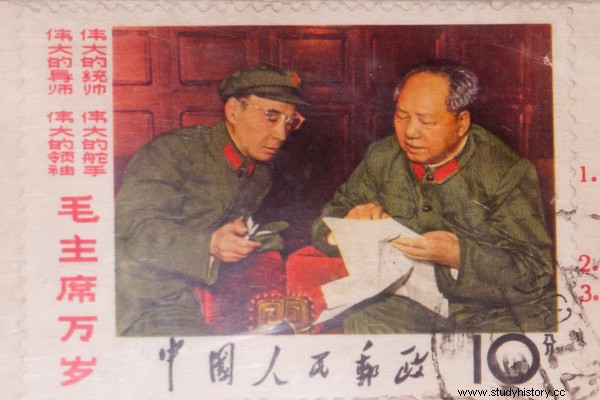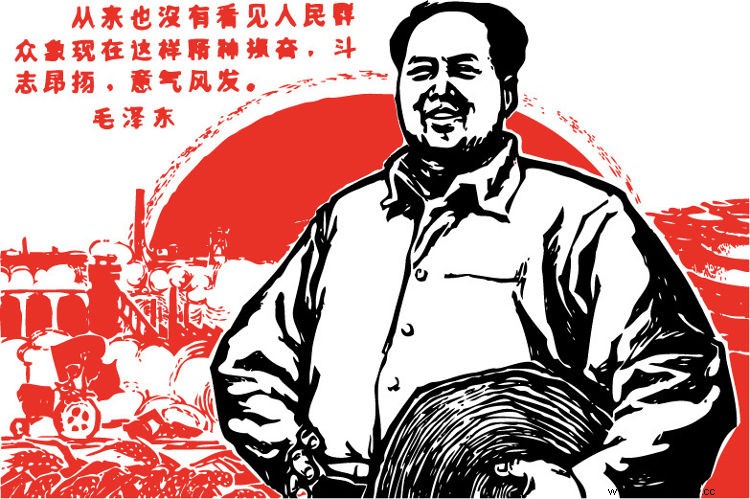Revolution Cultural was a campaign developed by Mao Tse-Tung from 1966 onwards, with the aim of persecuting his opponents within the party and members of society who did not align themselves with Mao's ideology. The Cultural Revolution lasted 10 years, spread violence in the country and resulted in the death of millions of Chinese citizens.
Go to also :Discover the story of one of the great genocides of the 20th century
Context of the Great Leap Forward
The Cultural Revolution is directly related to the failure of the Great Leap Forward (or Great Leap Forward), an economic plan developed by Mao Zedong, then president of China, during the 1950s. The idea of this plan was to promote industrialization from China, as the country at that time still had a very incipient industry.
During this plan, Mao promoted the creation of a series of communes and had peasants join them to produce iron and steel for Chinese industry. These peasants were forced to abandon the production of agricultural items to concentrate on metallurgy. The transfer of millions of workers to this activity ended up deregulating the Chinese economy.
The result of this was disastrous and China's agricultural production plummeted, so the country was forced to buy food from Western nations to mitigate these effects. As a result of the Great Leap in the early 1960s, China faced the Big Hunger, and historians claim that 20 million to 40 million people died from lack of food in the country.
Inside party dispute

The economic plan proposed by Mao, in addition to being a tragedy for the Chinese population, was bad for the leader's popularity within the Chinese Communist Party, the CCP. Mao began to be criticized, and a dispute for power and influence began to take shape in the cadres of that party.
Mao's faction, weakened by the failure of the Great Leap, began to visualize the growth of Liu Shao-Chi's faction and Deng Xiaoping , who had a more moderate view of the transformations and policies that Mao advocated for China. It was within this context that Mao planned the Cultural Revolution.
The criticism of Mao within the party were also a influence of de-Stalinization what happened in the Soviet Union. This process put an end to the cult of the leader in that country, especially Stalin, and this was reflected in China, especially in the way Mao was treated. De-Stalinization also contributed to the worsening of relations between the USSR and China, as Mao did not agree with the measures of the Soviet government.
What were the causes of the Cultural Revolution?
We can say that the immediate cause that led Mao to launch the Cultural Revolution was his desire to take back power that he had lost in China and within the CCP since the mid-1950s. The justification given by him, in the context of the revolution, to attack his opponents was to claim that these were bourgeois and conservatives who were distorting socialism in China.
Mao's idea was to remove people with more moderate views from positions of influence in the party, which included current Chinese President Liu Shao-Chi, one of Mao's biggest critics of the period. . In addition, party members who sought to maintain a cooperative relationship with the USSR should also be removed, according to Mao.
Login also :Vietnam War:conflict that unified an Asian nation under communist rule
Cultural Revolution

The Cultural Revolution was basically a policy of repression and censorship against those who thought differently from Mao. This kind of attitude had already been carried out by him when he was president of China. In the 1950s, the Three Anti campaigns , Five Anti and Anti-Rightist . These aimed to persecute capitalists, bourgeois and people who criticized the Chinese leader.
The Cultural Revolution was organized by Mao in partnership with his wife, a former Chinese actress named Jiang Qing . This one was part of the Gang of Four , a group of four people affiliated with the CCP who played a leading role in the 10 years of the revolution. In addition to Jiang Qing, this group was formed by Zhang Chunqiao , Wang Hongwen and Yao Wenyuan . Historians consider that a critique of a play called “The Dismissal of Hai Rui” was a prelude to what would come during the Cultural Revolution. This criticism was carried out by Yao Wenyuan, as quoted, one of the four members of the Gang of Four.
The Cultural Revolution officially started when Mao made the dispute within the CCP public and published the May 16th Circular . In that document he called on the people of China to help him in the fight against the reactionaries and the bourgeoisie growing in the country. This made the masses, especially students, adhere to Mao's call and start a period of violence in China.
- Red Guard
When Mao summoned the population, the Guard was created Red , a popular militia that followed Mao's ideas as they were recorded in the Book Red . Members of the Red Guard were scattered across China, spreading Maoism and denouncing those who criticized it and did not fit its ideals.
Red Guard members were told to pursue the “four old ”, a set of things that should be overcome in the country. Those things were the old ones ideas , the old cultures , the old ones customs and the old ones habits . Thus, one of the first targets of the revolution was the ancient Chinese culture.
-
Attacks, whistleblowers and censorship
Confucianism was attacked, as were ancient artifacts. Religion was also attacked and temples began to be destroyed across the country. The big targets of the Cultural Revolution were the intellectuals , such as scientists and teachers, in addition to the artist class. These were exactly the groups that most criticized Mao. Books that spread knowledge understood as Westerners were censored and burned.
The Cultural Revolution was truly an attempt to radically reform Chinese culture, definitively erasing traces of pre-revolutionary culture. The persecution of teachers in the country practically stopped the Chinese education system, especially higher education. Members of the Red Guard were instructed to denounce not only their teachers but also their parents.
Cases of violence against intellectuals and artists have skyrocketed. Those pursued by the Red Guard were sent back to “camps from reeducation ”, and in these places they were placed under forced labor, in addition to facing political re-education based on the principles of Maoism.
-
Trials and Forced Labor
Many of the targets of the Cultural Revolution were also sent to factories for forced labor. The idea in both cases was to re-educate people through manual labor , and it's important to mention that working conditions in both places were pretty bad.
Before being sent to these re-education camps, people went through trials carried out by the Red Guard. In these was common the humiliation public, in addition to aggressions which, in some cases, were so intense that some victims died.
The persecution spread to the major cities, and the violence of the Red Guards became so intense that Mao was forced to intervene in the situation through the use of the Chinese army in 1969. In that year, the Red Guards were disbanded, but the turmoil caused by the Cultural Revolution only ended when Mao died in 1976.
Login also :Korean War:conflict that had the accession of Chinese troops in 1950
Consequences of the Cultural Revolution
After Mao died, the Cultural Revolution ended and a new government took over China. In 1978, Deng Xiaoping , Mao's opponent who had been persecuted and sent to a re-education camp during the Cultural Revolution, assumed the presidency of China.
With the end of the revolution, some of the crimes committed by Mao's supporters were investigated and prosecuted, in this the case of the Gang of Four stands out. The four gang members were tried and convicted; Mao's wife, for example, was sentenced to death , but had his sentence changed to prison perpetual . She committed suicide in prison in 1991.
Furthermore, the Cultural Revolution is regarded as a dark period in China and is called “the lost decade” by the Chinese. The country became disorganized during this period, and any action aimed at China's development was put on the back burner. The priority in the country was the persecution of those who thought differently from their dictator.
Chinese education ceased to exist, especially higher education, as the persecution of university professors was intense. The productivity of China's economy became irregular and violence was one of the great hallmarks of this period. It is estimated that over a million people have died as a result of the Cultural Revolution.
Image credits
[1] Professional photography and Shutterstock
